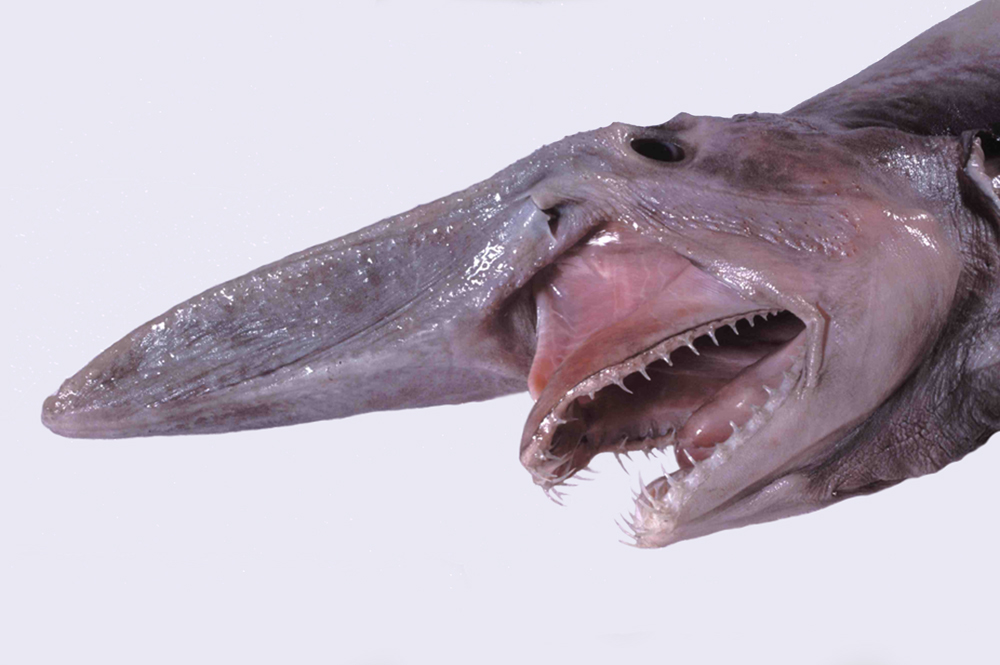

#Everblue 2 goblin shark skin
In Australia, wobbegong skin is used to make leather. They have many small but sharp teeth and their bite can be severe, even through a wetsuit having once bitten, they have been known to hang on and can be very difficult to remove. Wobbegongs are very flexible and can easily bite a hand holding onto their tail. The Australian Shark Attack File contains more than 50 records of unprovoked attacks by wobbegongs, and the International Shark Attack File 28 records, none of them fatal. Wobbegongs are generally not considered dangerous to humans, but have attacked swimmers, snorkelers, and scuba divers who inadvertently come close to them. The blood cells of several species of wobbegong have also been described. Wobbegongs also have a powerful jaw with needle-like teeth that assist in catching reef fish and other sharks for food. Wobbegongs make use of their camouflage to hide among rocks and catch smaller fish which swim too close, typical of ambush predators. The camouflage is improved by the presence of small weed-like whisker lobes surrounding the wobbegong's jaw, which help to camouflage it and act as sensory barbs. Because of this striking pattern, wobbegongs and their close relatives are often referred to as carpet sharks. Wobbegongs are well camouflaged with a symmetrical pattern of bold markings which resembles a carpet. halei, reach about 3 m (9.8 ft) in length. Most species have a maximum length of 1.25 m (4.1 ft), but the largest, the spotted wobbegong, Orectolobus maculatus, and banded wobbegong, O. Wobbegongs are bottom-dwelling sharks, spending much of their time resting on the sea floor. The word wobbegong is believed to come from an Australian Aboriginal language, meaning "shaggy beard", referring to the growths around the mouth of the shark of the western Pacific. They are found in shallow temperate and tropical waters of the western Pacific Ocean and eastern Indian Ocean, chiefly around Australia and Indonesia, although one species (the Japanese wobbegong, Orectolobus japonicus) occurs as far north as Japan. Wobbegong is the common name given to the 12 species of carpet sharks in the family Orectolobidae. Showing the camouflage pattern and skin flaps typical of wobbegongs “Anything that’s alive we try to put back in the ocean,” he said.Spotted wobbegong, Orectolobus maculatus, Moore released the shark after getting photographic evidence of his – and just about anyone’s – greatest fish story ever. He wants to share pictures of what he does with his grandson Keaton, who turns 4 on Wednesday. Moore just recently began carrying a camera with him on his shrimping expeditions. Carlson said he and a colleague now are writing a paper on goblin sharks to submit to a scientific journal.Īnd Carlson can thank a 3-year-old boy for that. The photographs Moore provided to NOAA will help expand that knowledge.


“We know little about (goblin sharks) – how long they live, how fast they grow.” One thing that’s fairly certain: At their size, goblin sharks have few natural predators, according to Carlson. “We don’t know a lot about deep water fauna,” Carlson said. Goblin sharks do resemble some prehistoric species, and Carlson said Moore made a “pretty important find.” They’re not seen anywhere all that often, though the coast of Japan boasts the shark’s share of recorded sightings.

“First thing I told them boys was, ‘Man, he’s ugly! Looks prehistoric to me,’” Moore said.
#Everblue 2 goblin shark full
Moore has been shrimping the Atlantic and the Gulf for 50 years, with a short break for a stint in the Air Force, and he’s “caught so much weird stuff: sawfish, Bahamian anglefish, loggerback turtles weighing 1,000 to 1,500 pounds.” But when the goblin shark spilled out of his trawling net full of royal red shrimp, Moore felt “disbelief.” “I was going to take the tape measure, then he flashed around again. Moore decided an exact appraisal wasn’t in his best interest. He caught it on April 19, about halfway through an 18-day fishing trip.Ĭarlson guesses it was closer to 15 feet, with the largest goblin shark ever measuring 18 feet. Carl Moore, 63, of Townsend, Georgia, was the unlikely archeologist of this ichthyological wonder, which he estimates was 18 to 20 feet long.


 0 kommentar(er)
0 kommentar(er)
